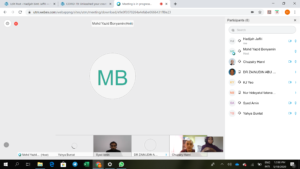We had a proposal defense of a PhD student yesterday. All went well for a while (around 30 minutes) and after that, glitches started to happen on my part. Even though I had permission to come to UTM and use my (uhuk uhuk unreliable) wifi in my office, but I have this urging feeling to test the speed and bandwith of my mobile modem that I bought last week. It has never been tested for Webex video conference where I would be involved actively as one of the speakers since I would be one of the examiners of this proposal defense. So, I decided to stay at home and participated in the Webex webinar or video conference using the mobile modem. (By the way, what is the difference between a webinar and video conference? I will explore the differences later)

So, what make the technical glitches to happen? This is the question that I ask myself (still finding more information to understand the glitches better). I started to google information about the required bandwith and devices capabilities to ensure a smooth webinar. I find out there are many factors that could influence Webex video conference. Here is the summary of some of the factors:
- For any webinar (Zoom, Webex etc.), it has different requirement for bandwith consumption of sending and receiving videos. Since I used Webex yesterday, what I share here is refering to my experience of glitches while using Webex (so others might have different experiences). So, I don’t know if others might experience similar things when they were using other platform like Zoom, Google Meet and such.
- For high quality video, it requires 90-130 kbps per video participant (minus screen sharing). Meaning, if you have many participants in the webinar that turn on their video and speakers (or in unmute mode), the bandwith consumption will be higher than 130kbps. So, for those with weak or low bandwith, they will experience glitches like not able to hear or see the host or the screen sharing
- Sender-receiver traffic also can influence the smoothness of a webinar or video conference session. I am not an expert in this. So, I don’t know how to calculate the sender-receiver traffic to minimise glitches. I need to find out more about this.
- Data sharing such as video or file sharing (Words, Powerpoint, PDF etc.) can also influence webinar session. If we use screen sharing, Webex webinar or video conference can require anywhere from Kbps (low-quality) to Mbps (immersive three-screen telepresence suite ). I got this information from here. But the rule of thumb is if there are many active participants in the session who turn on video and file sharing, the higher the bandwith consumption.
- Device capabilities refer to the device that you have in terms of the support provided by your device such as management provider, site requirements and such. This may be varied and influenced by the model of your devices. The rule of thumb in this case is the older device that you have, the less capabilities your device might have. In a much simpler explanation: Not all devices have equal capabilities in terms of its video and such.
How to minimise or rectify webinar glitches?
- Non-active participants need to turn off their video and mute their speaker.
- Limit your participant (IF you can)
- Don’t use screen sharing (at all, IF you can)
- Participants with low bandwith may try out some of these suggestions from Webex team.
But all seem impossible if you want to have active and interactive session with your students, right? So, what should you do?
